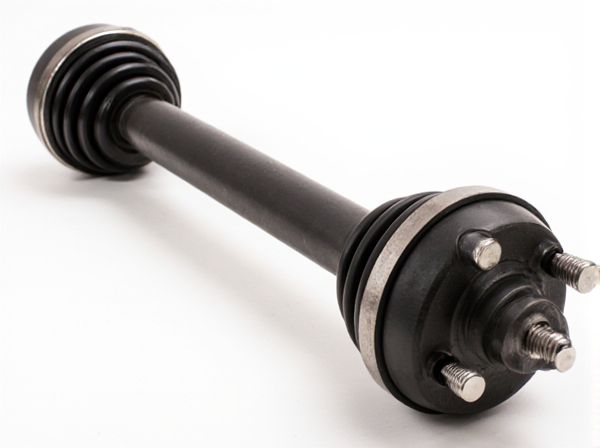
Photo illustration: Solid Axle vs Split Axle
Solid axles provide greater strength and durability for heavy-duty applications, ensuring reliable performance under tough conditions. Split axles offer enhanced flexibility and smoother ride quality, allowing each wheel to move independently and adapt to uneven terrain. Choosing between solid axle vs split axle depends on Your vehicle's intended use and the balance between robustness and ride comfort.
Table of Comparison
| Feature | Solid Axle | Split Axle |
|---|---|---|
| Design | Single rigid shaft connecting wheels | Two independent shafts for each wheel |
| Durability | Highly durable, with simpler construction | Less durable due to multiple components |
| Ride Comfort | Lower ride comfort, transfers shocks directly | Better shock absorption, smoother ride |
| Maintenance | Lower maintenance, fewer moving parts | Higher maintenance, more complex parts |
| Weight | Heavier due to solid construction | Lighter, as components are split |
| Cost | Lower manufacturing and repair costs | Higher costs because of complexity |
| Application | Heavy-duty vehicles, off-road trucks | Passenger cars, light vehicles |
Introduction to Axle Types
Solid axle and split axle are fundamental types of vehicle suspension systems, each offering unique performance characteristics. Solid axles consist of a single rigid beam connecting both wheels, providing durability and load-bearing strength, commonly found in trucks and off-road vehicles. Split axles, which have independent shafts for each wheel, enhance ride comfort and handling by allowing wheels to move independently, often used in passenger cars and performance vehicles.
What is a Solid Axle?
A solid axle is a single, rigid shaft that connects the wheels on opposite sides of a vehicle, ensuring they rotate together at the same speed. Commonly used in off-road and heavy-duty vehicles, solid axles provide durability and superior load-bearing capacity under uneven terrain conditions. This design contrasts with independent suspension systems, where each wheel moves independently, offering increased ride comfort and handling precision.
What is a Split Axle?
A split axle is a type of independent suspension system where each wheel is mounted on its own axle half, allowing for greater flexibility and improved handling over uneven terrain. Unlike a solid axle that connects both wheels with a single rigid beam, a split axle enables each wheel to move independently, enhancing ride comfort and traction. This design is commonly used in off-road vehicles and trucks to provide superior wheel articulation and reduce unsprung weight.
Key Differences: Solid Axle vs Split Axle
The key difference between solid axle and split axle lies in their structural design and functionality: a solid axle consists of a single rigid beam connecting both wheels, providing strength and durability ideal for heavy loads and off-road conditions. In contrast, a split axle has independently attached wheel hubs allowing each wheel to move separately, enhancing ride comfort and handling on uneven surfaces. Solid axles excel in robustness and load-bearing capacity, while split axles prioritize improved traction and suspension flexibility.
Performance Comparison
Solid axles deliver superior durability and load-bearing capacity due to their robust construction, making them ideal for heavy-duty off-road and towing applications. Split axles offer enhanced ride comfort and better traction on uneven terrain by allowing independent wheel movement, which improves handling and reduces wheel hop during acceleration. Performance-wise, solid axles excel in strength and simplicity, while split axles provide advanced suspension dynamics and smoother driving experiences.
Durability and Maintenance
Solid axles provide superior durability due to their robust, single-piece construction, making them well-suited for heavy-duty and off-road applications that demand high load capacity and resistance to impact. Maintenance on solid axles is generally simpler because of fewer moving parts, resulting in lower repair costs and less frequent servicing compared to split axles. Split axles, while offering enhanced wheel articulation and smoother ride quality, typically require more complex maintenance and are prone to increased wear on components like CV joints and bearings.
Applications in Vehicles
Solid axle designs offer superior durability and load-bearing capacity, making them ideal for heavy-duty trucks, off-road vehicles, and agricultural machinery where robustness and simplicity are critical. Split axles provide enhanced independent wheel movement, improving ride comfort and handling in passenger cars, SUVs, and performance vehicles that prioritize road grip and stability. Vehicle manufacturers select solid axles for rugged applications requiring strength, while split axles dominate in scenarios demanding advanced suspension dynamics and precise wheel articulation.
Pros and Cons of Solid Axles
Solid axles offer superior durability and load-bearing capacity, making them ideal for heavy-duty vehicles and off-road applications where strength is critical. Their simple design ensures easier maintenance and increased reliability under extreme conditions, though they often sacrifice ride comfort and handling precision due to unsprung weight and limited independent wheel movement. Solid axles can cause less smooth cornering and reduced traction on uneven surfaces compared to split axles, which provide better flexibility and ride quality but may be more complex and costly to maintain.
Pros and Cons of Split Axles
Split axles provide improved suspension articulation and better off-road performance due to their independent movement, which enhances traction on uneven terrain. They reduce unsprung weight compared to solid axles, resulting in improved ride comfort and handling on paved roads. However, split axles typically have increased complexity, higher maintenance costs, and reduced durability under heavy loads compared to solid axles.
Choosing the Right Axle for Your Needs
Choosing the right axle depends on vehicle application and load requirements; solid axles offer durability and strength ideal for heavy-duty off-road and towing, while split axles provide better ride comfort and handling for passenger vehicles. Solid axles maintain consistent alignment under heavy loads, making them suitable for trucks and SUVs, whereas split axles allow independent wheel movement, reducing unsprung weight and improving road grip. Prioritize your vehicle's purpose, terrain, and expected payload to select between the robust, dependable solid axle or the smooth, versatile split axle design.
 caratoz.com
caratoz.com